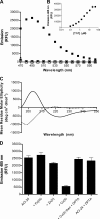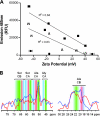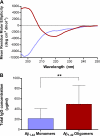Sequence-independent control of peptide conformation in liposomal vaccines for targeting protein misfolding diseases
- PMID: 21343310
- PMCID: PMC3077597
- DOI: 10.1074/jbc.M110.186338
Sequence-independent control of peptide conformation in liposomal vaccines for targeting protein misfolding diseases
Abstract
Synthetic peptide immunogens that mimic the conformation of a target epitope of pathological relevance offer the possibility to precisely control the immune response specificity. Here, we performed conformational analyses using a panel of peptides in order to investigate the key parameters controlling their conformation upon integration into liposomal bilayers. These revealed that the peptide lipidation pattern, the lipid anchor chain length, and the liposome surface charge all significantly alter peptide conformation. Peptide aggregation could also be modulated post-liposome assembly by the addition of distinct small molecule β-sheet breakers. Immunization of both mice and monkeys with a model liposomal vaccine containing β-sheet aggregated lipopeptide (Palm1-15) induced polyclonal IgG antibodies that specifically recognized β-sheet multimers over monomer or non-pathological native protein. The rational design of liposome-bound peptide immunogens with defined conformation opens up the possibility to generate vaccines against a range of protein misfolding diseases, such as Alzheimer disease.
Figures






References
-
- Misumi S., Nakayama D., Kusaba M., Iiboshi T., Mukai R., Tachibana K., Nakasone T., Umeda M., Shibata H., Endo M., Takamune N., Shoji S. (2006) J. Immunol. 176, 463–471 - PubMed
MeSH terms
Substances
LinkOut - more resources
Full Text Sources
Other Literature Sources
Medical

